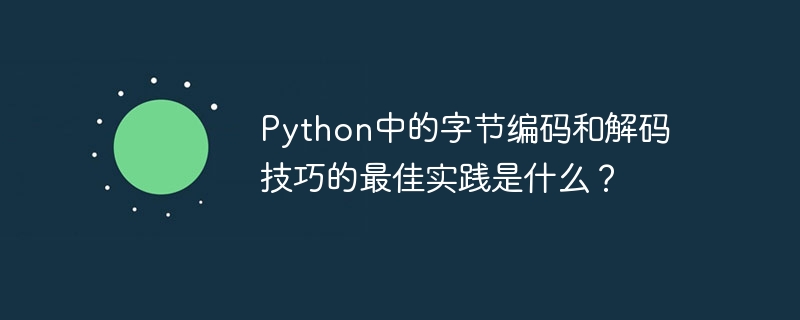Python中的字节编码和解码技巧的最佳实践是什么?

Python中的字节编码和解码技巧的最佳实践
在Python中,字节编码和解码是处理文本和数据的关键操作。正确的字节编码和解码技巧可以保证程序的正确性和运行效率。本文将介绍一些Python中的字节编码和解码的最佳实践,并提供具体的代码示例。
- 使用正确的编码:
在Python中,字符串可以是unicode形式的,也可以是字节形式的。在进行字符串的编码和解码操作时,需要注意使用正确的编码方式。常用的编码方式有UTF-8、GBK、ASCII等。如果没有指定编码方式,默认情况下Python会使用UTF-8编码。在进行编码和解码时,要确保使用的是相同的编码方式。 - 字符串与字节之间的转换:
在Python中,可以通过encode()方法将字符串转换为字节,通过decode()方法将字节转换为字符串。
# 将字符串转换为字节
str = "Hello World!"
byte = str.encode('utf-8')
print(byte)
# 将字节转换为字符串
byte = b'Hello World!'
str = byte.decode('utf-8')
print(str)- 错误处理:
在将字节解码为字符串时,有可能会遇到无法解码的情况。为了避免程序崩溃,可以通过设置errors参数来处理解码错误。常用的处理方式有'ignore'、'replace'、'strict'等。可以根据具体情况选择最适合的处理方式。
byte = b'é'
str = byte.decode('utf-8', errors='ignore')
print(str)- 文件的编码和解码:
在处理文件时,需要注意文件的编码方式。可以使用codecs模块来指定文件的编码方式进行读写操作。
import codecs
# 读取UTF-8编码的文本文件
with codecs.open('file.txt', 'r', 'utf-8') as file:
text = file.read()
print(text)
# 写入UTF-8编码的文本文件
with codecs.open('file.txt', 'w', 'utf-8') as file:
file.write('Hello World!')- 处理URL编码和解码:
在进行URL编码和解码时,可以使用urllib.parse模块中的urlencode()、quote()和unquote()方法。
from urllib.parse import urlencode, quote, unquote
# URL编码
params = {'name': '张三', 'age': 20}
encoded = urlencode(params)
print(encoded)
# URL解码
decoded = unquote(encoded)
print(decoded)
# 字符串URL编码
str = '你好'
encoded = quote(str)
print(encoded)
# 字符串URL解码
decoded = unquote(encoded)
print(decoded)在进行字节编码和解码时,需要注意编码方式的选择和错误处理的方法。通过使用Python提供的内置函数和模块,可以简化字节编码和解码的操作,并提高程序的性能和稳定性。
总结起来,Python中字节编码和解码的最佳实践包括使用正确的编码、字符串与字节之间的转换、错误处理、文件的编码和解码,以及处理URL编码和解码。以上技巧可以帮助开发者更加高效和准确地处理字节编码和解码的操作。
以上是Python中的字节编码和解码技巧的最佳实践是什么?的详细内容。更多信息请关注PHP中文网其他相关文章!

热AI工具

Undresser.AI Undress
人工智能驱动的应用程序,用于创建逼真的裸体照片

AI Clothes Remover
用于从照片中去除衣服的在线人工智能工具。

Undress AI Tool
免费脱衣服图片

Clothoff.io
AI脱衣机

AI Hentai Generator
免费生成ai无尽的。

热门文章

热工具

记事本++7.3.1
好用且免费的代码编辑器

SublimeText3汉化版
中文版,非常好用

禅工作室 13.0.1
功能强大的PHP集成开发环境

Dreamweaver CS6
视觉化网页开发工具

SublimeText3 Mac版
神级代码编辑软件(SublimeText3)

热门话题
 如何解决Linux终端中查看Python版本时遇到的权限问题?
Apr 01, 2025 pm 05:09 PM
如何解决Linux终端中查看Python版本时遇到的权限问题?
Apr 01, 2025 pm 05:09 PM
Linux终端中查看Python版本时遇到权限问题的解决方法当你在Linux终端中尝试查看Python的版本时,输入python...
 如何在10小时内通过项目和问题驱动的方式教计算机小白编程基础?
Apr 02, 2025 am 07:18 AM
如何在10小时内通过项目和问题驱动的方式教计算机小白编程基础?
Apr 02, 2025 am 07:18 AM
如何在10小时内教计算机小白编程基础?如果你只有10个小时来教计算机小白一些编程知识,你会选择教些什么�...
 在Python中如何高效地将一个DataFrame的整列复制到另一个结构不同的DataFrame中?
Apr 01, 2025 pm 11:15 PM
在Python中如何高效地将一个DataFrame的整列复制到另一个结构不同的DataFrame中?
Apr 01, 2025 pm 11:15 PM
在使用Python的pandas库时,如何在两个结构不同的DataFrame之间进行整列复制是一个常见的问题。假设我们有两个Dat...
 如何在使用 Fiddler Everywhere 进行中间人读取时避免被浏览器检测到?
Apr 02, 2025 am 07:15 AM
如何在使用 Fiddler Everywhere 进行中间人读取时避免被浏览器检测到?
Apr 02, 2025 am 07:15 AM
使用FiddlerEverywhere进行中间人读取时如何避免被检测到当你使用FiddlerEverywhere...
 Uvicorn是如何在没有serve_forever()的情况下持续监听HTTP请求的?
Apr 01, 2025 pm 10:51 PM
Uvicorn是如何在没有serve_forever()的情况下持续监听HTTP请求的?
Apr 01, 2025 pm 10:51 PM
Uvicorn是如何持续监听HTTP请求的?Uvicorn是一个基于ASGI的轻量级Web服务器,其核心功能之一便是监听HTTP请求并进�...
 哪些流行的Python库及其用途?
Mar 21, 2025 pm 06:46 PM
哪些流行的Python库及其用途?
Mar 21, 2025 pm 06:46 PM
本文讨论了诸如Numpy,Pandas,Matplotlib,Scikit-Learn,Tensorflow,Tensorflow,Django,Blask和请求等流行的Python库,并详细介绍了它们在科学计算,数据分析,可视化,机器学习,网络开发和H中的用途
 Python中如何通过字符串动态创建对象并调用其方法?
Apr 01, 2025 pm 11:18 PM
Python中如何通过字符串动态创建对象并调用其方法?
Apr 01, 2025 pm 11:18 PM
在Python中,如何通过字符串动态创建对象并调用其方法?这是一个常见的编程需求,尤其在需要根据配置或运行...







